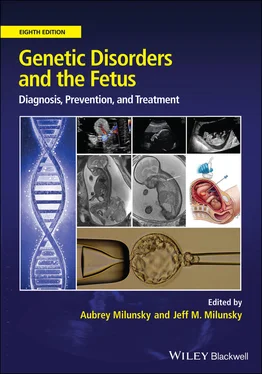Genetic Disorders and the Fetus
Здесь есть возможность читать онлайн «Genetic Disorders and the Fetus» — ознакомительный отрывок электронной книги совершенно бесплатно, а после прочтения отрывка купить полную версию. В некоторых случаях можно слушать аудио, скачать через торрент в формате fb2 и присутствует краткое содержание. Жанр: unrecognised, на английском языке. Описание произведения, (предисловие) а так же отзывы посетителей доступны на портале библиотеки ЛибКат.
- Название:Genetic Disorders and the Fetus
- Автор:
- Жанр:
- Год:неизвестен
- ISBN:нет данных
- Рейтинг книги:4 / 5. Голосов: 1
-
Избранное:Добавить в избранное
- Отзывы:
-
Ваша оценка:
- 80
- 1
- 2
- 3
- 4
- 5
Genetic Disorders and the Fetus: краткое содержание, описание и аннотация
Предлагаем к чтению аннотацию, описание, краткое содержание или предисловие (зависит от того, что написал сам автор книги «Genetic Disorders and the Fetus»). Если вы не нашли необходимую информацию о книге — напишите в комментариях, мы постараемся отыскать её.
Genetic Disorders and the Fetus — читать онлайн ознакомительный отрывок
Ниже представлен текст книги, разбитый по страницам. Система сохранения места последней прочитанной страницы, позволяет с удобством читать онлайн бесплатно книгу «Genetic Disorders and the Fetus», без необходимости каждый раз заново искать на чём Вы остановились. Поставьте закладку, и сможете в любой момент перейти на страницу, на которой закончили чтение.
Интервал:
Закладка:
Placental structure
Evaluating the placenta requires an understanding of its unique structure and development. The chorionic villi that compose the placenta are organized into 50–70 distinct tree‐like structures that grow in a clonal manner outwards from the chorionic plate into the basal plate (which interface with the maternal decidua). 1These villi are bathed in maternal blood, from which they sponge up nutrients important for fetal growth. The maternal blood is in direct contact with the outer trophoblast bilayer of the chorionic villi. This bilayer is made up of a multinucleated syncytium derived by fusion of the cytotrophoblast cells that form a single‐cell layer below the syncytium. In addition, some cytotrophoblasts form columns that migrate into and anchor the placenta to the uterine wall. Invasive cells that detach from these columns are termed extravillous trophoblasts (EVTs) and include the interstitial cytotrophoblasts (iCTBs) found in the decidual stroma and those that remodel maternal blood vessels, termed endovascular cytotrophoblasts (eCTBs). 1The inner core of the villi is the chorionic mesenchyme, which includes structural components, and a mix of cells including fetal blood vessels, fibroblasts, pericytes, and Hofbauer cells (placental macrophages). These extraembryonic cells derive from the epiblast of the blastocyst, from which the fetus is also derived.
Placental size is strongly correlated with fetal size; however, there is considerable variation in placental size for any given birthweight. 2The efficiency of the placenta depends on the surface area for exchange, thickness, and density of transporter proteins, 3and birthweight is highly associated with placental weight. 4Interestingly, mean placental size can vary between populations and even within a population over time because of changes in maternal nutrition or other environmental conditions. 5
Placental development and function
The placenta is responsible for many functions, which change as pregnancy proceeds. 1In early gestation, the primary roles of the placenta include invasion into the maternal endometrium, remodeling of maternal vasculature, and secretion of hormones important to maintain pregnancy. The placenta subsequently regulates blood flow and nutrient delivery to the fetus, buffers the fetus from adverse environmental effects, and generally performs the functions of multiple organs (lung, brain, kidney, immune system, etc.).
Implantation
During the invasion process, the early trophoblasts produce molecules to help them attach to and invade the uterine wall (e.g. integrins), prevent menstruation (e.g. human chorionic gonadotropin (hCG)), destroy the uterine matrix (e.g. matrix metalloproteinases), and suppress the maternal immune system (e.g. corticotropin‐releasing hormone (CRH)). 6 , 7hCG (encoded by CGA and CGB ) is one of the earliest hormones expressed from syncytiotrophoblast and stimulates many other processes. Multiple growth factors are important in regulating trophoblast proliferation, including placental growth factor (PlGF), epidermal growth factor (EGF), and transforming growth factor β (TGF‐β). In addition, microparticles, such as microvesicles (0.1–2 μm) and exosomes (30–100 nm), are released by the placental syncytium into maternal decidua and blood and may play a role in early maternal immune suppression and vascular remodeling. 8 – 11These microparticles provide a rich source of placental derived material detectable in maternal blood early in pregnancy that has the potential to be used in monitoring the pregnancy.
Failure of implantation and invasion can lead to early miscarriage. The majority of miscarriages occurring in the first trimester of pregnancy are associated with chromosome abnormalities, with trisomy, triploidy, and 45,X accounting for the vast majority of these. 12 , 13The reasons for implantation failure in chromosomally abnormal cases are likely complex, involving dysregulation of multiple important genes that then impede trophoblast growth and invasion. Trisomy for chromosomes 1, 11, and 19 are rarely observed even in early miscarriages, and presumably do not survive to clinical detection of pregnancy. Chromosome 19 not only has the highest gene density of any chromosome, but is sometimes referred to as the “placenta chromosome” because of the numerous placenta‐specific genes located on it, including the highly expressed pregnancy‐specific glycoprotein cluster (PSG), 14and the maternally imprinted chromosome 19 miRNA cluster (C19MC), the largest microRNA cluster in humans. 15Failure of implantation among genetically normal conceptuses can be due to a nonreceptive maternal environment resulting from disturbances in maternal hormone levels, immune health, anatomical interference, or a variety of maternal health conditions. 16
Angiogenesis
Placental angiogenesis and vasculogenesis serves to increase both uterine (maternal) and umbilical (fetal) blood flow. This process is dependent on a balance between pro‐ and antiangiogenic factors. 17Early in pregnancy, EVTs invade and plug the maternal uterine arteries, helping to maintain a low‐oxygen environment needed for trophoblast proliferation. 18Trophoblast cells (eCTBs) also migrate along the lumina of spiral arterioles, replacing the maternal endothelial lining. This expands the diameter of the maternal vessels and, in combination with gradual disintegration of the spiral artery plugs, results in a dramatic increase in blood flow after 12 weeks gestational age, which is needed to support fetal growth later in pregnancy. In turn, placental vasculature develops, and increases throughout gestation as the needs of the fetus grow. 19FGR can result from poor spiral artery remodeling or reduced vascular development within the placenta. Furthermore, insufficient remodeling of the maternal spiral arteries can result in a prolonged state of hypoxia and increased reoxygenation stress. This leads to increased syncytiotrophoblast apoptosis and necrosis, causing increased debris circulating in the maternal blood that has been associated with maternal PE. 20In addition to FGR and PE, abnormal spiral artery remodeling has been associated with placental abruption, preterm premature rupture of membranes, and intrauterine fetal death. 21
Nutrient delivery
Fetal growth is dependent on efficient nutrient delivery to the fetus. This is determined by maternal availability, maternal blood flow to the placenta, the amount of placental surface in contact with maternal blood, and the efficiency of placental transport. 22 , 23Transport of substances across the placenta can occur by (i) passive transport (simple or facilitated diffusion); (ii) active transport; and (iii) vesicular transport, by which large molecules are captured by microvesicles. A well‐functioning placenta can be extremely efficient at extracting nutrients for the fetus even when maternal supplies are low. For example, there is a threefold increase in folate concentration in the placenta compared with maternal blood; 24this is accomplished via several folate receptors highly expressed in the human placenta, including folate receptor 1 (FOLR1), proton‐coupled high‐affinity folate transporter (PCFT), and reduced folate carrier (RFC). 25As the fetus grows and requires more nutrients, the placenta alters gene expression to increase nutrient supply to the fetus; 26for example, upregulation of System A transporters can increase delivery of amino acids. 3 , 27There is also an increase in iron transport proteins, which absorb iron from maternal blood, 28and of placental CRH, which increases the production of maternal glucose needed to support the growing fetal brain. 29One pathway by which increased cortisol can lead to growth restriction is by interfering with CRH‐driven glucose production. 29
Читать дальшеИнтервал:
Закладка:
Похожие книги на «Genetic Disorders and the Fetus»
Представляем Вашему вниманию похожие книги на «Genetic Disorders and the Fetus» списком для выбора. Мы отобрали схожую по названию и смыслу литературу в надежде предоставить читателям больше вариантов отыскать новые, интересные, ещё непрочитанные произведения.
Обсуждение, отзывы о книге «Genetic Disorders and the Fetus» и просто собственные мнения читателей. Оставьте ваши комментарии, напишите, что Вы думаете о произведении, его смысле или главных героях. Укажите что конкретно понравилось, а что нет, и почему Вы так считаете.












